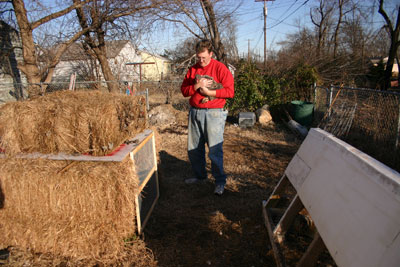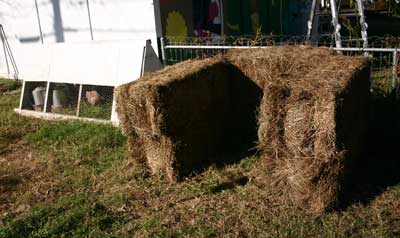You are currently browsing the category archive for the ‘Passive solar’ category.
I took temperature readings inside and outside our passive-solar henhouse on New Year’s Day. At 2:30 in the afternoon, the outdoor air temperature was in the high 40s, the temperature in the sunshine on the ground in front of the henhouse was 61, and the temperature inside the henhouse was 72.
Getting the hens out of the chicken tractor and into the new structure was something of a trick. We were using pavers to hold the door shut, and our barred Rock, Solitaire, proved much stronger and much more willing to squeeze through a small space than we’d expected. We’d put Solitaire into the henhouse, carefully secure the door, and as soon as we turned our backs, she’d come sauntering back out the side. It was pretty funny. We finally gave up on the pavers and used a couple of big logs from the woodpile to hold the door shut, which worked a lot better.
Once the girls were back together, they calmed down and quit trying to sneak out. The quarters were a little tight, and I don’t think they liked being walled in like that — after all, they’re used to being outdoors — but their temporary home did a good job of protecting them from the elements when temperatures dropped into the teens for a couple of nights, and I slept better knowing my girls were safe and warm, even if they weren’t very happy with me.
Emily

As I think we’ve mentioned before, we keep a half-dozen backyard hens here at the House of the Lifted Lorax. We usually keep them in their chicken tractor — a kind of portable henhouse — to give them access to fresh forage while protecting them from the neighborhood cats. (You can see our chicken tractor to the right in the photo above.)
During extreme cold, the hens need a little more protection than the tractor offers, so with forecasts calling for temperatures in the teens on Tuesday night, we spent this afternoon finishing up a project I started a couple of months ago: a passive-solar, biodegradable henhouse.
We started by arranging six hay bales to form three thick walls:

(You can see another view of the chicken tractor to the left in the picture above.)
Next, Ron cut a piece of half-inch plywood to fit over the top. I think the dimensions were something like four feet by five feet.

I used some leftover spray paint from other projects to seal the plywood, which hopefully will help keep it from delaminating in wet weather.
Using L-brackets and T-brackets, I screwed some 1x2s together to form a simple frame that’s reinforced in the center. I attached two hinges at the top and stapled some half-inch hardware cloth to the back side of the frame to make a screen door. (You could probably use chicken wire, but we thought the hardware cloth would be a little sturdier.)
I screwed the hinges to the plywood, we put two more hay bales on top, and — voila! — a little house:

I will run out to the hardware store later and pick up a roll of clear Frost-King plastic and a couple of cinder blocks. I’ll use about a yard of plastic to cover the door, stapling it to the plywood to make a flap we can raise and lower as necessary to regulate the temperature inside the henhouse. The cinder blocks will be used to secure the door, as there’s not much way to attach hardware to hay bales to make a latch.
I’m guessing our girls are probably the only hens in Tulsa County who will be spending the coldest nights of the year in a passive-solar house with an R-value somewhere in the neighborhood of 45. 🙂
I’ll pick up a couple of thermometers at the hardware store this afternoon and take some readings inside and outside the henhouse to get an idea of how it will perform. Stay tuned….
Emily
I never was the most liberal, tree-hugging member of any party. So how did I become the type of person who now recycles, drives a hybrid, and is about to place power-producing solar panels on my home?
I guess I could say that I married into the environmental movement, which is true. But that’s too easy of an explanation.
One of the first inklings of my interest in alternative housing was in college, when a newspaper article told about actor Dennis Weaver building a house in Colorado made with discarded tires. I distinctly recall reading that Weaver’s house had a constant, year-round temperature like a cave, so that it would cost much less to heat and cool during seasonal extremes. I remember how cool I thought that was.
I didn’t have the chance until the Internet age to further research Weaver’s house, which I discovered was an Earthship. Emily and I ultimately didn’t build an Earthship (maybe someday), but it sparked a lot of ideas on how to lessen our power consumption and improve our home’s climate control.
But my interest in environmentally friendly methods goes back further, while growing up on the farm in the Midwest. My grandfather used passive solar heat to help dry the grain that he harvested instead of relying so much on noisy, power-eating electric dryers. A few dozen miles away, another farmer erected a wind turbine and generated enough power during some months to get the electric company to pay him.
But it wasn’t just neato gadgets and new ways to pinch pennies. My parents also instilled in us that we were stewards of the land, that it was our duty to leave it in as good or better condition for the next generation of farmers. That led to no-till planting to conserve the topsoil. That led to cutting back on the use of herbicides and insecticides because my family instinctively knew that overuse of such chemicals was harmful.
It wasn’t Al Gore or Iron Eyes Cody or, God forbid, Earth First! that ultimately led me to being more environmentally responsible. It was my years on the windswept Illinois prairie.

Recent Comments